Twenty years ago, the only people doing explosive SARQ—speed, agility, reactivity and quickness—training or working out with advanced fitness equipment like agility ladders or speed parachutes were elite athletes training with professional strength and conditioning coaches. Over the past 10 years or so, a number of the specialized training strategies and techniques that were once the exclusive domain of top athletes have found their way into the commercial fitness space. These techniques are now frequently used by personal trainers working with their weight-loss clients and by group fitness instructors looking to create a unique exercise experience for their participants.
If you’ve noticed people in your gym or neighborhood park jumping over hurdles, running around cones or dragging a sled behind them and wondered: A) if it really works or B) whether it’s something that you should try, the answer to both is a resounding YES. Here are seven benefits to SARQ training, each one a potent reason why you should consider adding it to your exercise program.
SARQ training is fun. One of the most common reasons why people stop their exercise programs is because they find running or cycling in one place on a piece of equipment relatively boring and it can be hard to make the time for something that provides little-to-no actual enjoyment. However, if exercise is appropriately challenging and engaging, it’s a little more exciting and becomes something you look forward to as opposed to something you dread.
SARQ training can help improve your movement skill and body awareness. While athletes of all levels use SARQ training to improve their sport-specific skills, you do not need to be a competitive athlete to receive the benefits of improved coordination and body awareness. Speed training improves the rate of force production—the speed at which muscles contract—which can diminish over the course of the normal biological aging process. Agility training can improve dynamic balance, which is the ability to maintain control of a moving center of mass over a changing base of support. Reactivity and quickness drills can enhance natural reflexes, helping you to move faster in almost everything you do. SARQ training can help improve movement skill and coordination for adults of all ages. It also helps help older adults improve their dynamic balance, allowing them to remain functionally independent well into their later years.
1. SARQ training produces results you can both see and measure. Soccer players are revered for their toned, well-defined legs because the rapid changes of direction and speed required for success in their sport involve all of the muscles in their legs, thus producing aesthetic results that can not be replicated by a single exercise or machine. Most SARQ exercises use the same lower-body muscles, which means you don’t need to play a sport to develop a sleek, toned look. An additional feature of SARQ training is that you can easily track your progress. Pick a drill that is used for professional football try-outs, such as a three-cone shuttle run, and time yourself as you run it. Record that time and, at a later date, time yourself again to measure your improvements.
2. SARQ training uses more muscles than linear running, which can help you burn more calories during your workout. Think of driving in the city compared to driving on a highway—the former requires frequent starts and stops, which burns more fuel, while the latter maintains a consistent rate of speed, which helps to conserve energy. The body uses approximately 5 calories of energy to consume one liter of oxygen. When more muscles are involved during exercise, the body requires more oxygen, which increases the amount of energy that is expended. Most, if not all, of the leg muscles are needed to overcome the forces of gravity and ground reaction to control the body’s ability to make multiple changes of direction and frequent changes of speed (a hallmark of SARQ training), while running at a constant pace in a linear direction does not engage the leg muscles in the same ways.
3. SARQ training is a form of high-intensity interval training (HIIT), which is an effective way to burn a lot of calories in a limited amount of time. In fact, it can actually help you continue to burn calories after you’ve finished your workout. SARQ drills can cover approximately 10 to 50 meters and should be run at the fastest rate of speed possible. This can burn a lot of calories, but requires complete rest intervals between repetitions to allow for energy replenishment and nervous system recovery. The ability to burn calories after the workout is over is technically known as excess post-exercise oxygen consumption (EPOC) and can be a big help to those with weight-loss goals.
4. SARQ training can help reduce the risk of a number of different types of injuries. Performing the same movement patterns over and over again can lead to tissue fatigue and repetitive stress injury, while quickly changing speed or direction can lead to a strain if the involved tissue is not able to adequately mitigate the applied forces. SARQ training is movement variability training, which is not only effective for strengthening the contractile element of muscle, but also for improving the strength and resiliency of the elastic fascia and connective tissue, thus improving its ability to rapidly lengthen and shorten. This can help minimize the risk of many injuries related to rapid changes of speed or direction.
5. SARQ training is a great way to connect with your kids. It can be hard to find things in common with your kids, but if you learn how to do an agility ladder or execute rapid changes of direction, you can feel comfortable going out and shooting baskets or kicking a ball around with your kids, thus giving you more opportunities to spend time with them.
Despite the perception that SARQ training is only for people playing sports, you don’t need to be a professional or scholarship athlete to receive benefits from this mode of exercise. Due to its challenging nature, SARQ training places a tremendous amount of stress on the muscles, connective tissues, joints and bones of the lower body. Start slow and gradually increase the complexity (number of direction changes), the distance covered, speed of movement, and the number of different drills and repetitions for each drill.
When learning SARQ exercise, the main components of proper form include:
1. Foot placement—make ground contact with the widest part of your foot, and allow your whole foot to roll down before explosively pushing off of the ground
2. Body placement—maintain center of mass over base of support, decelerate forward movement with your feet in front of your body while maintaining a hips-flexed position
3. Posture—keep your spine straight, and dip down for turns by hinging from hips rather than rounding the spine
4. Arm action—for extra speed, keep your elbows bent at 90 degrees and focus your movement from the shoulders by driving your elbows back; your right hand should brush against the outside of your right hip and come up to cheek height
5. Leg action—as you drive your right leg into the ground, rapidly bring your left knee up while keeping your left foot dorsiflexed (pulled closer to the left shin)
BASIC WARM-UP
To ensure that your muscles and connective tissue are completely warm and pliable, perform two to three sets of 12 to 15 reps of each of the following exercises, resting for approximately 30 seconds rest between each set (for walking, crawling or jogging exercises, walk approximately 5 to 10 meters for one set).
1. Bodyweight squats
2. Posterior lunges with forward reach
3. Hurdle walks
4. Crossover walks
5. Bear crawls
6. Ice-skaters
7. Fast high-knee skips
8. Back-pedal-to-high-knee
9. Lateral shuffle to forward run (5-meter shuffle to 5-meter run)
BASIC SARQ WORKOUT
Requires a 5-meter section of agility ladder and cones
Agility ladder—run through the ladder and walk back to the start for active recovery; perform three to five reps of each exercise:
1. High knees: 1 foot in each square
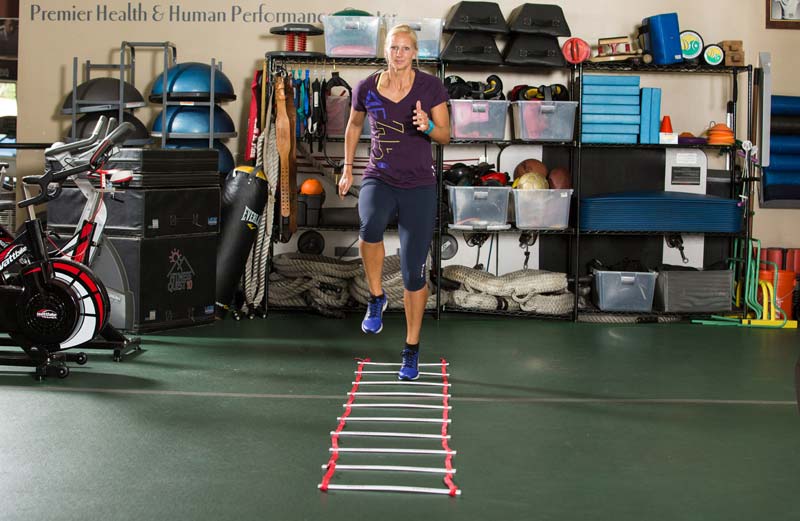
2. High knees: 2 feet in each square
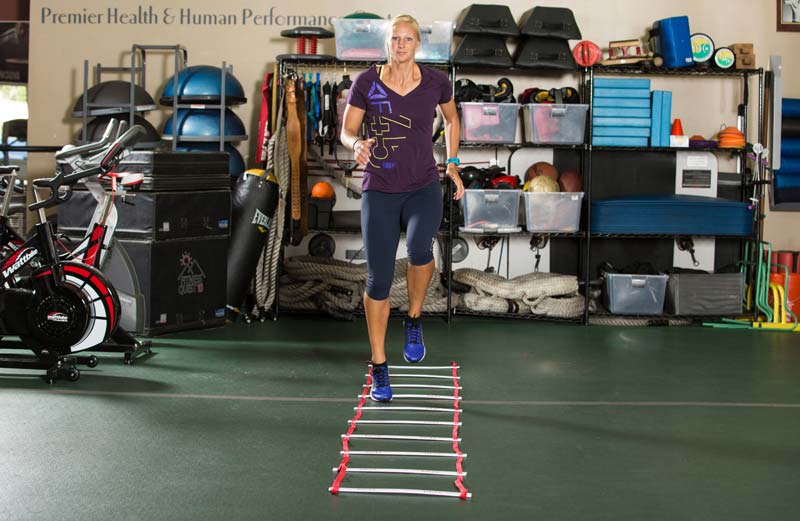
3. Lateral high-knees: 2 feet in each square, do the same number of reps in each direction
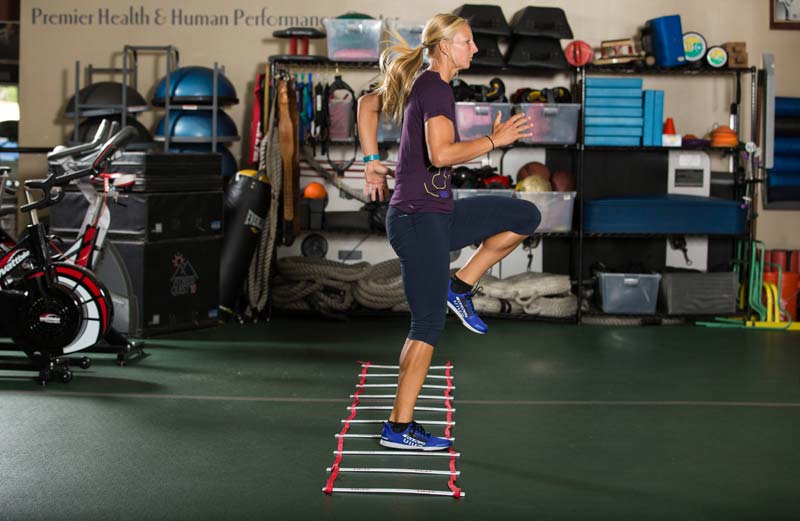 4. Hop-scotch: Move your feet in and out through each square while jumping forward
4. Hop-scotch: Move your feet in and out through each square while jumping forward
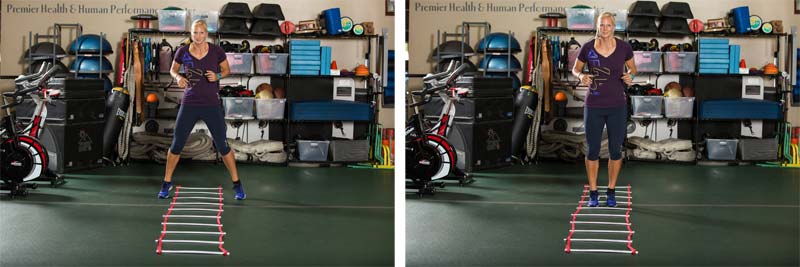
CONE DRILLS
Set up two cones approximately 10 meters apart. Perform four to six reps of each exercise, resting 15 to 30 seconds between each rep. As you feel yourself getting better, increase the distance between the cones, add more reps or reduce the rest time to increase the level of intensity.
1. Forward run to backpedal

2. Forward run to quick 180-degree turn around cone—keep feet moving while making the turn and do the same number of reps in each direction
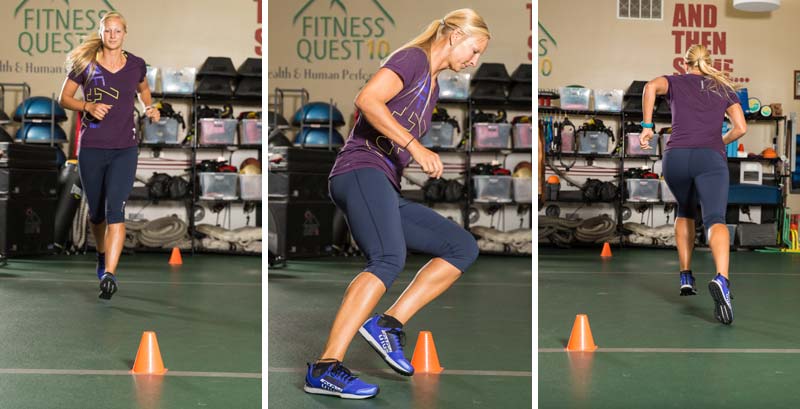
3. Forward run to backpedal to lateral shuffle—run forward, then backward, then quickly change directions and shuffle between the two cones
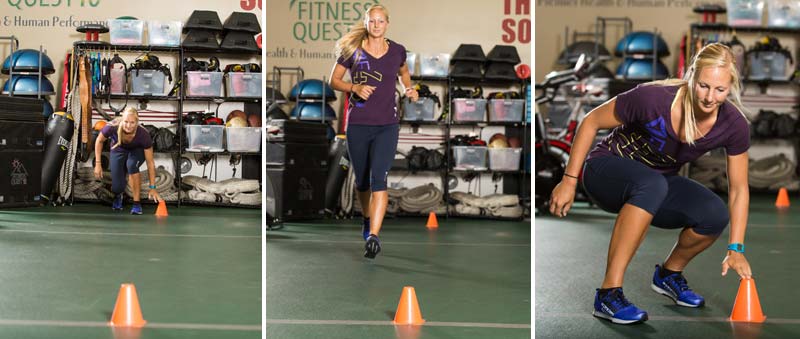
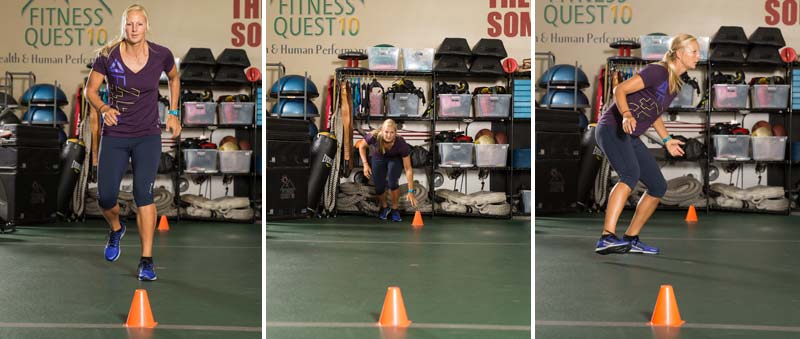
ADVANCED SARQ WORKOUT
Requires a 5-meter section of agility ladder and cones
Do the basic workout (above) and add four to six reps of each of the following exercises:
Agility ladder
Lateral crossovers—When moving to your right, cross your left foot in front of your body and push your left foot laterally to the left to move to the right, alternate sides
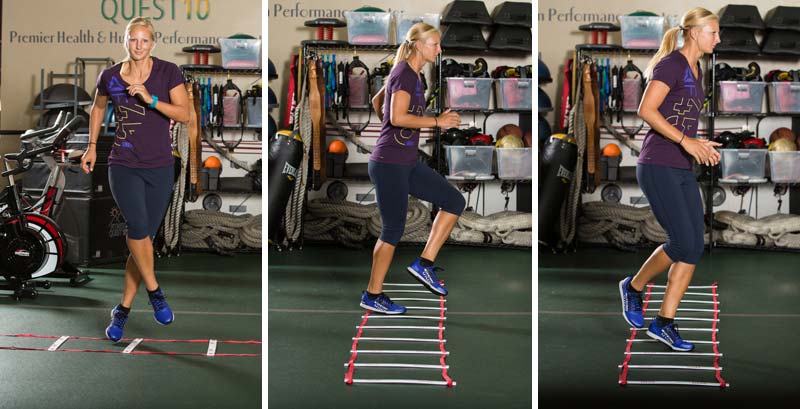
T-drill—a standard footwork drill for many sports
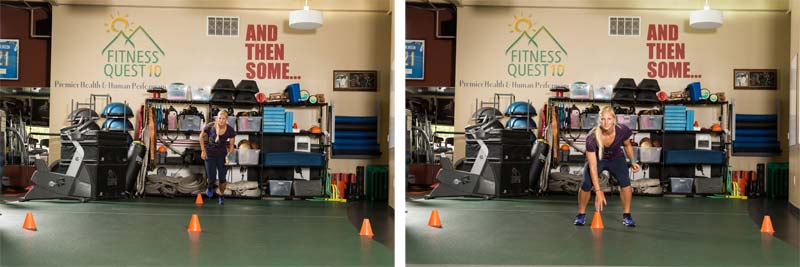

3-cone shuttle drill—a standard agility test for professional football players
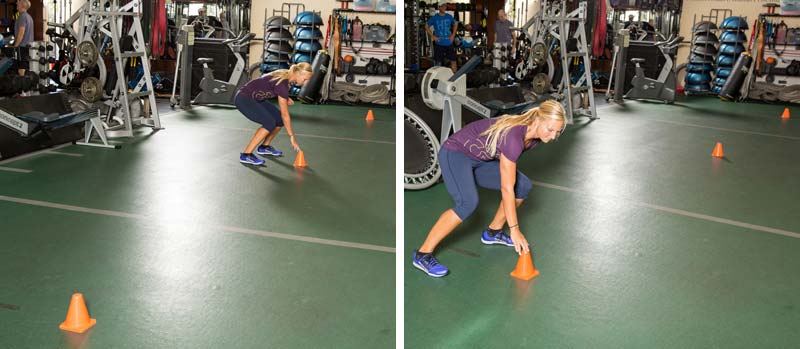
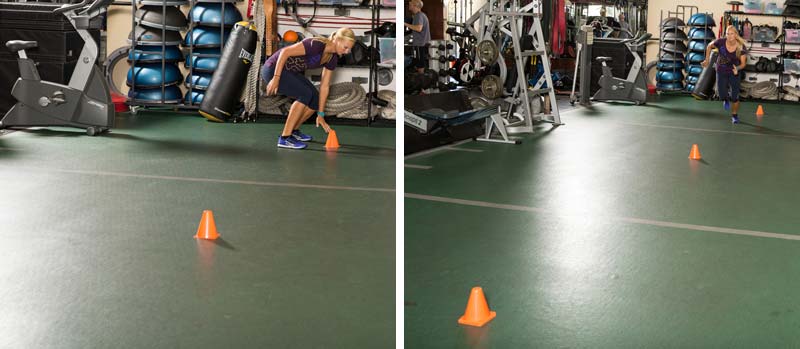
3-cone L-drill—another drill used for professional football players
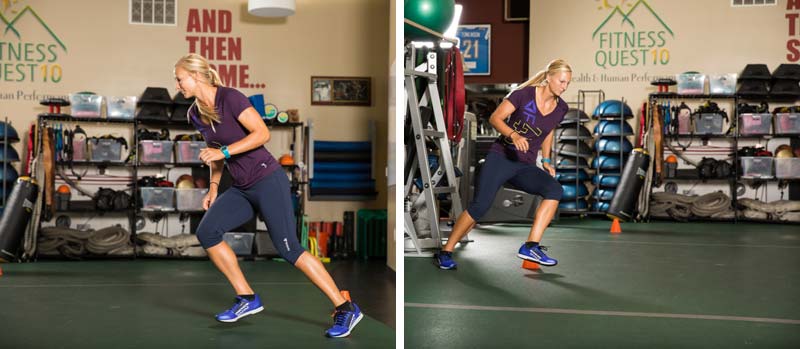
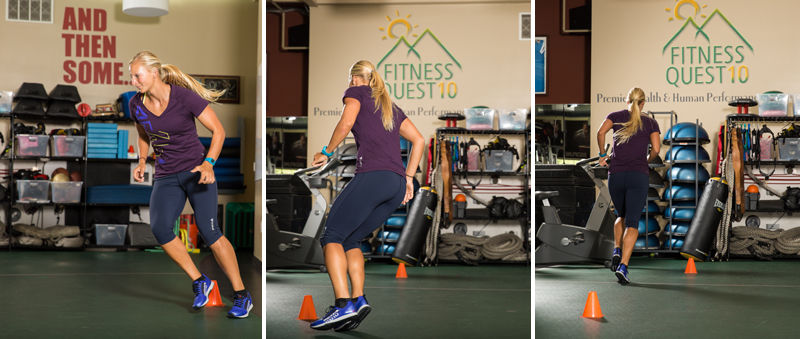
SARQ training can be an extremely fun and effective way to get results from your exercise programs. If you want a SARQ workout for your specific needs, contact an ACE Certified Personal Trainer or look for a SARQ-specific class taught by an ACE Certified Group Fitness Instructor.




 by
by 




 by
by